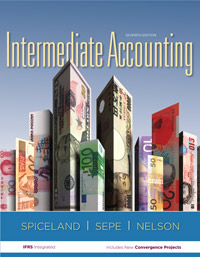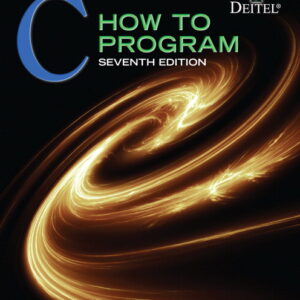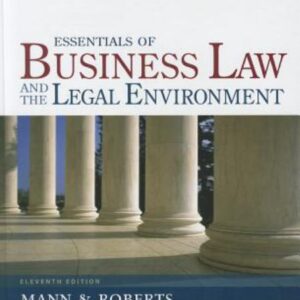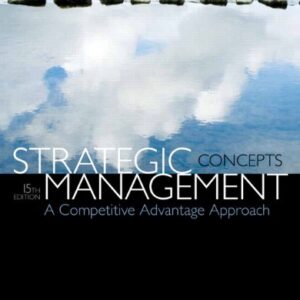Test Bank for Intermediate Accounting 7 edition. David Spiceland, James F. Sepe, Mark W. Nelson
$35.00
Test Bank for Intermediate Accounting 7 edition. David Spiceland, James F. Sepe, Mark W. Nelson
Chapter 01 Environment and Theoretical Structure of Financial Accounting Answer Key
True / False Questions
1. The primary function of financial accounting is to provide relevant financial information to parties external to business enterprises.
TRUE
AACSB: Reflective Thinking
AICPA BB: Critical Thinking
Blooms: Remember
Difficulty: 1 Easy
Learning Objective: 01-01 Describe the function and primary focus of financial accounting.
Topic: Financial Accounting Environment
2. Accrual accounting attempts to measure revenues and expenses that occurred during accounting periods so they equal net operating cash flow.
FALSE
AACSB: Reflective Thinking
AICPA BB: Critical Thinking
Blooms: Understand
Difficulty: 1 Easy
Learning Objective: 01-02 Explain the difference between cash and accrual accounting.
Topic: Cash versus Accrual Accounting
3. The FASB is currently the public-sector organization responsible for setting accounting standards in the United States.
FALSE
AACSB: Reflective Thinking
AICPA BB: Critical Thinking
Blooms: Remember
Difficulty: 1 Easy
Learning Objective: 01-03 Define generally accepted accounting principles (GAAP) and discuss the historical development of accounting standards; including convergence between U.S. and international standards.
Topic: The Development of Financial Accounting and Reporting Standards
4. The FASB’s due process invites various interested parties to indicate their opinions about whether financial accounting standards should be changed.
TRUE
AACSB: Reflective Thinking
AICPA BB: Critical Thinking
Blooms: Remember
Difficulty: 1 Easy
Learning Objective: 01-04 Explain why the establishment of accounting standards is characterized as a political process.
Topic: The Establishment of Accounting Standards
5. Accounting for stock-based compensation is an area in which the FASB has received little political interference.
FALSE
AACSB: Reflective Thinking
AICPA BB: Critical Thinking
Blooms: Remember
Difficulty: 1 Easy
Learning Objective: 01-04 Explain why the establishment of accounting standards is characterized as a political process.
Topic: The Establishment of Accounting Standards
6. The Public Reform and Investor Protection Act of 2002 (Sarbanes-Oxley) changed the entity responsible for setting auditing standards in the United States.
TRUE
AACSB: Reflective Thinking
AICPA BB: Critical Thinking
Blooms: Remember
Difficulty: 1 Easy
Learning Objective: 01-05 Explain factors that encourage high-quality financial reporting.
Topic: Encouraging High-Quality Financial Reporting
7. A rules-based approach to standard setting stresses professional judgment as opposed to following a list of rules.
FALSE
AACSB: Reflective Thinking
AICPA BB: Critical Thinking
Blooms: Remember
Difficulty: 1 Easy
Learning Objective: 01-05 Explain factors that encourage high-quality financial reporting.
Topic: Encouraging High-Quality Financial Reporting
8. Under federal securities laws, the SEC has the authority to set accounting standards in the United States.
TRUE
AACSB: Reflective Thinking
AICPA BB: Critical Thinking
Blooms: Remember
Difficulty: 1 Easy
Learning Objective: 01-05 Explain factors that encourage high-quality financial reporting.
Topic: Encouraging High-Quality Financial Reporting
9. The primary responsibility for properly applying GAAP when communicating with investors and creditors through financial statements lies with a firm’s auditors.
FALSE
AACSB: Reflective Thinking
AICPA BB: Critical Thinking
Blooms: Remember
Difficulty: 1 Easy
Learning Objective: 01-05 Explain factors that encourage high-quality financial reporting.
Topic: Encouraging High-Quality Financial Reporting
10. Auditors play an important role in the resource allocation process by adding credibility to financial statements.
TRUE
AACSB: Reflective Thinking
AICPA BB: Critical Thinking
Blooms: Understand
Difficulty: 1 Easy
Learning Objective: 01-05 Explain factors that encourage high-quality financial reporting.
Topic: Encouraging High-Quality Financial Reporting
11. The purpose of the conceptual framework is to provide a structure and framework for a consistent set of GAAP.
TRUE
AACSB: Reflective Thinking
AICPA BB: Critical Thinking
Blooms: Remember
Difficulty: 1 Easy
Learning Objective: 01-06 Explain the purpose of the conceptual framework.
Topic: The Conceptual Framework
12. In the United States the conceptual framework indicates GAAP when a more specific accounting standard does not apply.
FALSE
AACSB: Reflective Thinking
AICPA BB: Critical Thinking
Blooms: Remember
Difficulty: 1 Easy
Learning Objective: 01-06 Explain the purpose of the conceptual framework.
Topic: The Conceptual Framework
13. Materiality can be affected by the dollar amount of an item, the nature of the item, or both.
TRUE
AACSB: Reflective Thinking
AICPA BB: Critical Thinking
Blooms: Remember
Difficulty: 1 Easy
Learning Objective: 01-07 Identify the objective and qualitative characteristics of financial reporting information; and the elements of financial statements.
Topic: Objective, Qualitative Characteristics of Financial Reporting and Elements of Financial Statements
14. According to the FASB’s Statements of Financial Accounting Concepts, conservatism is a desired qualitative characteristic of accounting information.
FALSE
AACSB: Reflective Thinking
AICPA BB: Critical Thinking
Blooms: Remember
Difficulty: 1 Easy
Learning Objective: 01-07 Identify the objective and qualitative characteristics of financial reporting information; and the elements of financial statements.
Topic: Objective, Qualitative Characteristics of Financial Reporting and Elements of Financial Statements
15. Equity is a residual amount representing the owner’s interest in the assets of the business.
TRUE
AACSB: Reflective Thinking
AICPA BB: Critical Thinking
Blooms: Remember
Difficulty: 1 Easy
Learning Objective: 01-07 Identify the objective and qualitative characteristics of financial reporting information; and the elements of financial statements.
Topic: Objective, Qualitative Characteristics of Financial Reporting and Elements of Financial Statements
16. Revenues are inflows or other enhancements of assets or settlements of liabilities from activities that constitute the entity’s ongoing operations.
TRUE
AACSB: Reflective Thinking
AICPA BB: Critical Thinking
Blooms: Remember
Difficulty: 1 Easy
Learning Objective: 01-07 Identify the objective and qualitative characteristics of financial reporting information; and the elements of financial statements.
Topic: Objective, Qualitative Characteristics of Financial Reporting and Elements of Financial Statements
17. Gains or losses result, respectively, from the disposition of business assets for greater than, or less than, theirvalues.
TRUE
AACSB: Reflective Thinking
AICPA BB: Critical Thinking
Blooms: Remember
Difficulty: 1 Easy
Learning Objective: 01-07 Identify the objective and qualitative characteristics of financial reporting information; and the elements of financial statements.
Topic: Objective, Qualitative Characteristics of Financial Reporting and Elements of Financial Statements
18. Comprehensive income is another term for net income.
FALSE
AACSB: Reflective Thinking
AICPA BB: Critical Thinking
Blooms: Remember
Difficulty: 1 Easy
Learning Objective: 01-07 Identify the objective and qualitative characteristics of financial reporting information; and the elements of financial statements.
Topic: Objective, Qualitative Characteristics of Financial Reporting and Elements of Financial Statements
19. The FASB’s conceptual framework lists relevance and timeliness as the two fundamental qualitative characteristics of decision useful information.
FALSE
AACSB: Reflective Thinking
AICPA BB: Critical Thinking
Blooms: Remember
Difficulty: 1 Easy
Learning Objective: 01-07 Identify the objective and qualitative characteristics of financial reporting information; and the elements of financial statements.
Topic: Objective, Qualitative Characteristics of Financial Reporting and Elements of Financial Statements
20. The monetary unit assumption requires that items in financial statements be measured in a particular monetary unit.
TRUE
AACSB: Reflective Thinking
AICPA BB: Critical Thinking
Blooms: Remember
Difficulty: 1 Easy
Learning Objective: 01-08 Describe the four basic assumptions underlying GAAP.
Topic: Underlying Assumptions
21. The periodicity assumption requires that present value calculations take into account the number of compounding periods in each year.
FALSE
AACSB: Reflective Thinking
AICPA BB: Critical Thinking
Blooms: Remember
Difficulty: 1 Easy
Learning Objective: 01-08 Describe the four basic assumptions underlying GAAP.
Topic: Underlying Assumptions
22. Determining fair value by calculating the present value of future cash flows is a level 1 type of input.
FALSE
AACSB: Reflective Thinking
AICPA BB: Critical Thinking
Blooms: Remember
Difficulty: 1 Easy
Learning Objective: 01-09 Describe the recognition; measurement and disclosure concepts that guide accounting practice.
Topic: Recognition, Measurement, and Disclosure Concepts
23. The FASB’s framework for measuring fair value doesn’t change the situations in which fair value is used under current GAAP.
TRUE
AACSB: Reflective Thinking
AICPA BB: Critical Thinking
Blooms: Remember
Difficulty: 1 Easy
Learning Objective: 01-09 Describe the recognition; measurement and disclosure concepts that guide accounting practice.
Topic: Recognition, Measurement, and Disclosure Concepts
24. The revenue/expense approach emphasizes determining the appropriate amounts of revenue and expense in each reporting period.
TRUE
AACSB: Reflective Thinking
AICPA BB: Critical Thinking
Blooms: Remember
Difficulty: 1 Easy
Learning Objective: 01-10 Contrast a revenue/expense approach and an asset/liability approach to accounting standard setting.
Topic: Evolving GAAP
25. The asset/liability approach emphasizes matching to determine what assets and liabilities should be reflected on the balance sheet.
FALSE
AACSB: Reflective Thinking
AICPA BB: Critical Thinking
Blooms: Remember
Difficulty: 1 Easy
Learning Objective: 01-10 Contrast a revenue/expense approach and an asset/liability approach to accounting standard setting.
Topic: Evolving GAAP
26. In IFRS, the conceptual framework indicates appropriate accounting when a more specific accounting standard does not apply.
TRUE
AACSB: Reflective Thinking
AICPA BB: Critical Thinking
Blooms: Remember
Difficulty: 1 Easy
Learning Objective: 01-11 Discuss the primary differences between U.S. GAAP and IFRS with respect to the development of accounting standards and the conceptual framework underlying accounting standards.
Topic: International Financial Reporting Standards
27. The funding of the standard-setting bodies that promulgate IFRS is as independent as that underlying U.S. GAAP.
FALSE
AACSB: Reflective Thinking
AICPA BB: Critical Thinking
Blooms: Remember
Difficulty: 1 Easy
Learning Objective: 01-11 Discuss the primary differences between U.S. GAAP and IFRS with respect to the development of accounting standards and the conceptual framework underlying accounting standards.
Topic: International Financial Reporting Standards
Multiple Choice Questions
28. External decision makers would not look primarily to financial accounting information to assist them in making decisions on:
A. Granting credit.
B. Capital budgeting.
C. Selecting stocks.
D. Mergers and acquisitions.
AACSB: Reflective Thinking
AICPA BB: Critical Thinking
Blooms: Understand
Difficulty: 1 Easy
Learning Objective: 01-01 Describe the function and primary focus of financial accounting.
Topic: Financial Accounting Environment
29. Corporations issue their shares to the investing public in the:
A. Option a
B. Option b
C. Option c
D. Option d
AACSB: Reflective Thinking
AICPA FN: Reporting
Blooms: Remember
Difficulty: 1 Easy
Learning Objective: 01-01 Describe the function and primary focus of financial accounting.
Topic: Financial Accounting Environment
30. The primary focus for financial accounting information is to provide information useful for:
A. Option a
B. Option b
C. Option c
D. Option d
AACSB: Reflective Thinking
AICPA FN: Reporting
Blooms: Remember
Difficulty: 1 Easy
Learning Objective: 01-01 Describe the function and primary focus of financial accounting.
Topic: Financial Accounting Environment
31. Which of the following groups is not among the external users for whom financial statements are prepared?
A. Customers.
B. Suppliers.
C. Employees.
D. All of the above are external users of financial statements.
AACSB: Reflective Thinking
AICPA FN: Reporting
Blooms: Remember
Difficulty: 1 Easy
Learning Objective: 01-01 Describe the function and primary focus of financial accounting.
Topic: Financial Accounting Environment
32. Which of the following is not true about net operating cash flow?
A. It is the difference between cash receipts and cash disbursements from providing goods and services.
B. It is a measure used in accrual accounting and is recognized as the best predictor of future operating cash flows.
C. Over short periods, it may not be indicative of long-run cash-generating ability.
D. It is easy to understand and all information required to measure it is factual.
AACSB: Reflective Thinking
AICPA BB: Critical Thinking
Blooms: Remember
Difficulty: 2 Medium
Learning Objective: 01-01 Describe the function and primary focus of financial accounting.
Topic: Financial Accounting Environment
33. Which of the following groups is not among financial intermediaries?
A. Mutual fund managers.
B. Financial analysts.
C. CPAs.
D. Credit rating organizations.
AACSB: Reflective Thinking
AICPA BB: Critical Thinking
Blooms: Remember
Difficulty: 2 Medium
Learning Objective: 01-01 Describe the function and primary focus of financial accounting.
Topic: Financial Accounting Environment
34. Which of the following was the first private-sector entity that set accounting standards in the United States?
A. Accounting Principles Board.
B. Committee on Accounting Procedure.
C. Financial Accounting Standards Board.
D. AICPA.
AACSB: Reflective Thinking
AICPA BB: Critical Thinking
Blooms: Remember
Difficulty: 2 Medium
Learning Objective: 01-01 Describe the function and primary focus of financial accounting.
Topic: Financial Accounting Environment
35. Which of the following does not apply to secondary markets?
A. Transactions are important to the efficient allocation of resources in our economy.
B. New resources are provided when shares of stock are sold by the corporation to the initial owners.
C. Transactions help to establish market prices for additional shares that may be issued in the future.
D. Many investors might be unwilling to provide resources to corporations if there is no available mechanism for the future sale of their stocks and bonds to others.
AACSB: Reflective Thinking
AICPA BB: Critical Thinking
Blooms: Remember
Difficulty: 2 Medium
Learning Objective: 01-01 Describe the function and primary focus of financial accounting.
Topic: Financial Accounting Environment
36. Porite Company recognizes revenue in the period in which it records an asset for the related account receivable, rather than in the period in which the account receivable is collected in cash. Porite’s practice is an example of:
A. Cash basis accounting.
B. Accrual accounting.
C. The matching principle.
D. Economic entity.
AACSB: Reflective Thinking
AICPA FN: Reporting
Blooms: Create
Difficulty: 1 Easy
Learning Objective: 01-02 Explain the difference between cash and accrual accounting.
Topic: Cash versus Accrual Accounting
37. Which of the following is not a potential benefit of accrual accounting, compared to cash-basis accounting?
A. Timeliness.
B. Better reflecting economic activity.
C. Periodicity.
D. Better matching of revenues and expenses.
AACSB: Reflective Thinking
AICPA FN: Reporting
Blooms: Create
Difficulty: 1 Easy
Learning Objective: 01-02 Explain the difference between cash and accrual accounting.
Topic: Cash versus Accrual Accounting
38. In a recent annual report, Apple Computer reported the following in one of its disclosure notes: “Warranty Expense: The Company provides currently for the estimated cost for product warranties at the time the related revenue is recognized.” This note exemplifies Apple’s use of:
A. Conservatism.
B. The matching principle.
C. Realization principle.
D. Economic entity.
AACSB: Reflective Thinking
AICPA BB: Critical Thinking
Blooms: Create
Difficulty: 2 Medium
Learning Objective: 01-09 Describe the recognition; measurement and disclosure concepts that guide accounting practice.
Topic: Recognition, Measurement, and Disclosure Concepts
39. GAAP is an abbreviation for:
A. Generally authorized accounting procedures.
B. Generally applied accounting procedures.
C. Generally accepted auditing practices.
D. Generally accepted accounting principles.
AACSB: Reflective Thinking
AICPA BB: Critical Thinking
Blooms: Remember
Difficulty: 1 Easy
Learning Objective: 01-03 Define generally accepted accounting principles (GAAP) and discuss the historical development of accounting standards; including convergence between U.S. and international standards.
Topic: The Development of Financial Accounting and Reporting Standards
40. The FASB issues accounting standards in the form of:
A. Accounting Research Bulletins.
B. Accounting Standards Updates.
C. Financial Accounting Standards.
D. Financial Technical Bulletins.
AACSB: Reflective Thinking
AICPA BB: Critical Thinking
Blooms: Remember
Difficulty: 1 Easy
Learning Objective: 01-03 Define generally accepted accounting principles (GAAP) and discuss the historical development of accounting standards; including convergence between U.S. and international standards.
Topic: The Development of Financial Accounting and Reporting Standards
41. Pronouncements issued by the Committee on Accounting Procedures:
A. Dealt with specific accounting and reporting problems.
B. Were based on exposure drafts and public comment letters.
C. Originated from congressional studies and SEC directives.
D. Were the outcome of research studies and a theoretical framework.
AACSB: Reflective Thinking
AICPA BB: Critical Thinking
Blooms: Remember
Difficulty: 1 Easy
Learning Objective: 01-03 Define generally accepted accounting principles (GAAP) and discuss the historical development of accounting standards; including convergence between U.S. and international standards.
Topic: The Development of Financial Accounting and Reporting Standards
42. The FASB’s standard-setting process includes, in the correct order:
A. Exposure draft, research, discussion paper, Accounting Standards Update.
B. Research, exposure draft, discussion paper, Accounting Standards Update.
C. Research, discussion paper, exposure draft, Accounting Standards Update.
D. Discussion paper, research, exposure draft, Accounting Standards Update.
AACSB: Reflective Thinking
AICPA BB: Critical Thinking
Blooms: Remember
Difficulty: 1 Easy
Learning Objective: 01-03 Define generally accepted accounting principles (GAAP) and discuss the historical development of accounting standards; including convergence between U.S. and international standards.
Topic: The Development of Financial Accounting and Reporting Standards
43. Which of the following is not a provision of the Public Company Accounting Reform and Investor Protection Act of 2002 (Sarbanes-Oxley)? The Act:
A. Changed the entity responsible for setting auditing standards.
B. Increased corporate executive responsibility for financial statements.
C. Limited nonaudit services that can be performed by auditors for audit clients.
D. Changed the entity responsible for setting accounting standards.
AACSB: Reflective Thinking
AICPA BB: Critical Thinking
Blooms: Remember
Difficulty: 1 Easy
Learning Objective: 01-03 Define generally accepted accounting principles (GAAP) and discuss the historical development of accounting standards; including convergence between U.S. and international standards.
Topic: The Development of Financial Accounting and Reporting Standards
44. CPAs are licensed by:
A. The AICPA.
B. The SEC.
C. The federal government.
D. State governments.
AACSB: Reflective Thinking
AICPA BB: Critical Thinking
Blooms: Remember
Difficulty: 1 Easy
Learning Objective: 01-03 Define generally accepted accounting principles (GAAP) and discuss the historical development of accounting standards; including convergence between U.S. and international standards.
Topic: The Development of Financial Accounting and Reporting Standards
45. Which of the following has the statutory authority to set accounting standards in the United States?
A. FASB.
B. IRS.
C. SEC.
D. AICPA.
AACSB: Reflective Thinking
AICPA BB: Critical Thinking
Blooms: Remember
Difficulty: 1 Easy
Learning Objective: 01-03 Define generally accepted accounting principles (GAAP) and discuss the historical development of accounting standards; including convergence between U.S. and international standards.
Topic: The Development of Financial Accounting and Reporting Standards
46. When a registrant company submits its annual filing to the SEC, it uses:
A. Form 10-A.
B. Form 10-K.
C. Form 10-Q.
D. Form S-1.
AACSB: Reflective Thinking
AICPA FN: Reporting
Blooms: Remember
Difficulty: 1 Easy
Learning Objective: 01-03 Define generally accepted accounting principles (GAAP) and discuss the historical development of accounting standards; including convergence between U.S. and international standards.
Topic: The Development of Financial Accounting and Reporting Standards
47. The most likely important flaw leading to the demise of the APB was the perceived lack of:
A. Confidence.
B. Competence.
C. Independence.
D. Importance.
AACSB: Reflective Thinking
AICPA BB: Critical Thinking
Blooms: Remember
Difficulty: 2 Medium
Learning Objective: 01-03 Define generally accepted accounting principles (GAAP) and discuss the historical development of accounting standards; including convergence between U.S. and international standards.
Topic: The Development of Financial Accounting and Reporting Standards
48. Accounting standard setting has been characterized as:
A. A political process.
B. Using the scientific method.
C. Pure deductive reasoning.
D. Pure inductive reasoning.
AACSB: Reflective Thinking
AICPA BB: Critical Thinking
Blooms: Remember
Difficulty: 1 Easy
Learning Objective: 01-04 Explain why the establishment of accounting standards is characterized as a political process.
Topic: The Establishment of Accounting Standards
49. The International Accounting Standards Board:
A. Was the predecessor to the IASC.
B. Can overrule the FASB when their policies disagree.
C. Promotes the use of high-quality, understandable global accounting standards.
D. Has its headquarters in Geneva.
AACSB: Reflective Thinking
AICPA BB: Critical Thinking
Blooms: Remember
Difficulty: 1 Easy
Learning Objective: 01-03 Define generally accepted accounting principles (GAAP) and discuss the historical development of accounting standards; including convergence between U.S. and international standards.
Topic: The Development of Financial Accounting and Reporting Standards
50. Which of the following is not a provision of the Public Company Accounting Reform and Investor Protection Act of 2002?
A. Corporate executive accountability.
B. Auditor rotation.
C. Retention of work papers.
D. All of the above are provisions of the Act.
AACSB: Reflective Thinking
AICPA BB: Critical Thinking
Blooms: Remember
Difficulty: 1 Easy
Learning Objective: 01-03 Define generally accepted accounting principles (GAAP) and discuss the historical development of accounting standards; including convergence between U.S. and international standards.
Topic: The Development of Financial Accounting and Reporting Standards
51. The primary professional organization for those accountants working in the industry is the:
A. AAA.
B. AICPA.
C. IIA.
D. IMA.
AACSB: Reflective Thinking
AICPA BB: Critical Thinking
Blooms: Remember
Difficulty: 1 Easy
Learning Objective: 01-03 Define generally accepted accounting principles (GAAP) and discuss the historical development of accounting standards; including convergence between U.S. and international standards.
Topic: The Development of Financial Accounting and Reporting Standards
52. In the Norwalk Agreement, the FASB and IASB pledged to:
A. Combine their organizations to form the BUSYB.
B. Make progress on specific MOU projects.
C. Achieve convergence by the year 2015.
D. Remove existing differences between their standards.
AACSB: Reflective Thinking
AICPA BB: Critical Thinking
Blooms: Remember
Difficulty: 1 Easy
Learning Objective: 01-03 Define generally accepted accounting principles (GAAP) and discuss the historical development of accounting standards; including convergence between U.S. and international standards.
Topic: The Development of Financial Accounting and Reporting Standards
53. “Condorsement”:
A. Is a term used by the IASB to refer to the conditional endorsement process used by the EU with respect to IFRS.
B. Describes a combination of convergence and endorsement that the SEC suggested the United States might use in the future to incorporate IFRS into U.S. GAAP.
C. Was coined by a representative of the AICPA to describe the lengthy convergence process.
D. Has nothing to do with the convergence process.
AACSB: Reflective Thinking
AICPA BB: Critical Thinking
Blooms: Remember
Difficulty: 1 Easy
Learning Objective: 01-03 Define generally accepted accounting principles (GAAP) and discuss the historical development of accounting standards; including convergence between U.S. and international standards.
Topic: The Development of Financial Accounting and Reporting Standards
54. The most political issue in the FASB’s most recent deliberations and amendments to GAAP on business combinations was:
A. The negative effects on subsequent earnings of amortizing goodwill if firms were required to use the purchase method of accounting for the combination.
B. The negative effects on subsequent earnings of amortizing goodwill if firms were required to use the pooling method of accounting for the combination.
C. The unrealistic balance sheet assets that would be created if firms were required to use the purchase method of accounting for the combination.
D. The unrealistic balance sheet assets that would be created if firms were required to use the pooling method of accounting for the combination.
AACSB: Reflective Thinking
AICPA BB: Critical Thinking
Blooms: Understand
Difficulty: 2 Medium
Learning Objective: 01-04 Explain why the establishment of accounting standards is characterized as a political process.
Topic: The Establishment of Accounting Standards
55. The primary historical reason for the FASB reversing its positions when political pressures occur is:
A. The cost of gathering data was prohibitive.
B. The difficulties in measurement were too great.
C. They have no authority in such situations.
D. The SEC did not support the FASB position.
AACSB: Reflective Thinking
AICPA BB: Critical Thinking
Blooms: Remember
Difficulty: 2 Medium
Learning Objective: 01-04 Explain why the establishment of accounting standards is characterized as a political process.
Topic: The Establishment of Accounting Standards
56. The most recent example of the political process at work in standard setting is the heated debate that occurred on the issue of:
A. Pension plan accounting.
B. Accounting for postretirement benefits other than pensions.
C. Accounting for business combinations.
D. Accounting for stock-based compensation.
AACSB: Reflective Thinking
AICPA BB: Critical Thinking
Blooms: Understand
Difficulty: 2 Medium
Learning Objective: 01-04 Explain why the establishment of accounting standards is characterized as a political process.
Topic: The Establishment of Accounting Standards












Reviews
There are no reviews yet.